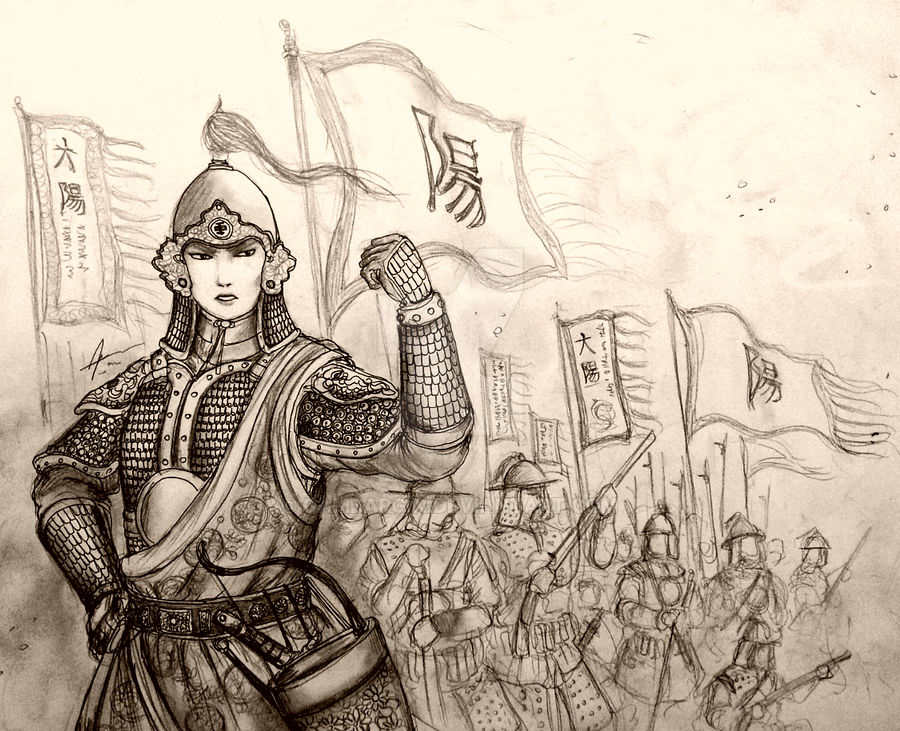Deviation Actions
Description
We all know the Persian who fought with the Greeks, Alexander who sat his foot to India, the Romans who subjugated most of the known world, the Spanish who went on conquering the new world and so forth. Hence, it can be fairly said that their great legacy shall forever be remembered in the annals of history. But amongst all those great legacy of the west and the oriental, we cannot simply ignore the fact that, in many of the cases, the Chinese, for over many centuries, have made themselves equal to the rest of the world powers, in their technology, mathematics, philosophy, military, navy as well as sheer brutality. While Rome was still young in its republican days, China was already an Empire. While europe was busy with their petty conflicts and conservative feudalism, China had established a brutal and efficient administrative system, with many neighboring kingdoms paying tribute to the great empire. These were just some of the examples that the Chinese had achieved with their brilliance and ambition in the history.
Historically speaking, China under the Ming Dynasty was considered one of their greatest period in the History. At one time, while Europeans were busy with their petty conflicts, Ming Empire was the largest, had the most numerous standing army, as well as the largest fleet, commanded under Zeng He, whose voyage have reached as far as East Africa (and perhaps America, depending on whom you talk to). Their administrative system was considered much complex and advanced to their time, enabling the increasingly autocratic government to easily control the populace. Many of the ambitious building projects, such as the reparation of Great Wall, forbidden city, and Grand Canal, were built during this timeline by the Ming, further establishing their prestige and influence to the rest of the world. However, 17th century was different, Ming Dynasty was plagued by natural disasters, internal instability, rebellions and increasingly disillusioned population. Further on, the Manchurian were already on the move to conquer China and eventually emerged victorious. This marked the end of the Chinese Han ruling Dynasty, and paved a way for the Manchurian to establish one of the world's greatest Empire, the Qing.
In this drawing, Princess Wu Shang Xiang is drawn in the stylized Chinese Ming Lamellar/scale armor of the latter period, showing the increasingly artistic and ornate design while still being practical in combat. The armor was commonly worn by generals or powerful officials, holding titles similar to that of counts or dukes. Given the nature of the political and military situation of the Empire, Princess Shang Xiang was put in precarious positions between competing factions in the imperial court. She was educated in the ways of a proper court lady, as well as all the dark intrigues beneath it. Women warriors or women fighting in the Chinese histories is not uncommon, judging by the meritocratic and bureaucratic nature of the imperial rule, powerful women could simply overpower their foe through any means necessary (and most often succeeded), whether the act could be justified or not.
Her noble family branch descended from the Chinese Woman Warriors in the previous series, the Wu twins
 , whose legacy political ambitions and ruthlessness, still held high by her. As the period she is in is rather turbulent, and the increasingly ambitious Japanese and Manchus may spell the inevitable death or exile.
, whose legacy political ambitions and ruthlessness, still held high by her. As the period she is in is rather turbulent, and the increasingly ambitious Japanese and Manchus may spell the inevitable death or exile.===================================================================================================
Potential Rivals:

Credit and Many thanks to
More on the Factions of historically wrong Sketch Series set in 17th century, Project Blood and Steel

Most of the gorgeous armors of the Ming Dynasty were only worn by soldiers who belonged to the royal guards. For example, the Tai Han Generals (大漢將軍) who belonged to Jinyiwei (錦衣衛), they were actually royal guards, not generals. Most frontline soldiers wore 罩甲, the steel plate of armor cannot be seen from outside, its has a short waist armor and a long body armor. The long body armor can cover the calf. For high rank soldiers, commanders or generals who worn 明甲. The steel plate of that armor is exposed, and there are also has short waist armor and long body armor. If the short waist armor is worn, the lower body will wear dress armor. Most of the Chinese armor is not gorgeous, because in many dynasties in China, the status of soldiers was not high. The gorgeous armor will only be worn by soldiers who performing royal guards to show the authority of the royal family.






























